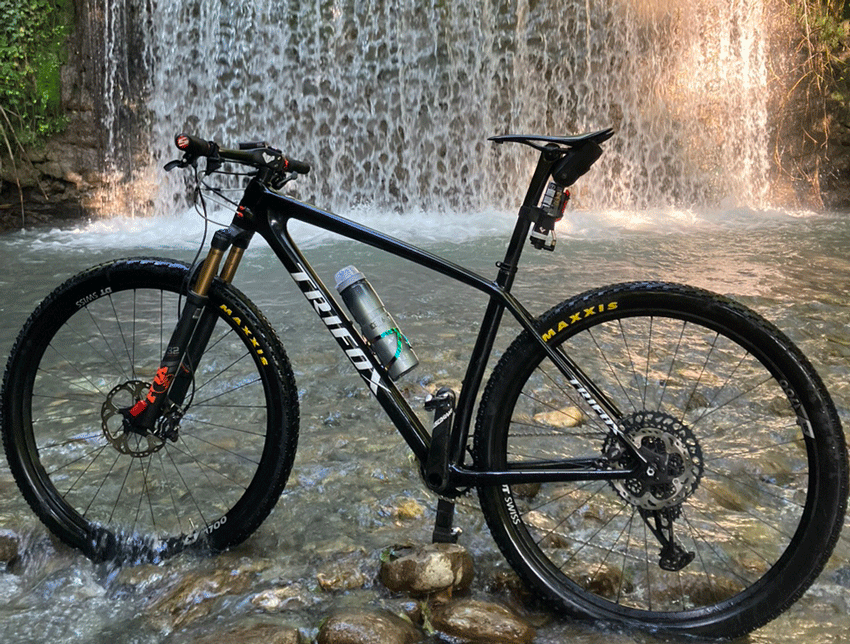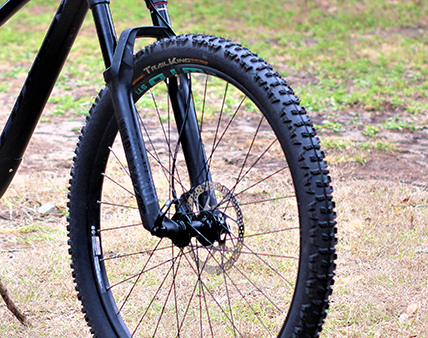If you are a mountain biker, then you know that your handlebars are your main connection to your bike. That is why choosing the perfect handlebars is crucial for your performance, comfort, and safety. Handlebars come in various materials, shapes, and sizes, and each one has its own advantages and disadvantages. However, selecting the right handlebars can be overwhelming due to the vast options available.
1. Width
The width of your handlebars determines the control and stability you have while riding. The ideal handlebar width depends on your body structure, riding style, and the terrain you ride on. Generally, wider handlebars provide more control and stability, while narrow handlebars are ideal for technical riding. To determine the ideal width, stand up and measure the distance between your shoulder blades, then add 2-4 inches. This measurement will give you the perfect handlebar width for your body structure.
2. Material
Mountain bike handlebars are made of different materials, such as carbon fiber, aluminum, and titanium. Carbon fiber handlebars are the lightest and most expensive, but they offer the most shock absorption and comfort. Aluminum handlebars are the most popular choice among mountain bikers due to their affordability, durability, and stiffness. Titanium handlebars are light and strong, but they are the most expensive option. Choose the material that suits your budget and riding style.
3. Shape
Mountain bike handlebars come in various shapes, including flat, riser, and drop bars. Flat handlebars are ideal for cross-country riding and provide a more upright riding position. Riser handlebars are suitable for downhill riding and provide a more aggressive riding position. Drop bars are common in road cycling, but they are not recommended for mountain biking. Choose the shape that suits your riding style, terrain, and comfort.
4. Sweep
The sweep refers to the angle at which the handlebars bend back towards the rider. The sweep affects the hand position, wrist alignment, and comfort. Generally, handlebars with more sweep provide a more natural wrist position and are more comfortable for longer rides. However, too much sweep can affect steering precision and control. Choose the sweep angle that feels comfortable for your hand position and riding style.
5. Rise
The rise refers to the amount of distance the handlebars rise above the stem. The rise affects the riding position and comfort. Handlebars with more rise provide a more upright position and are suitable for cross-country riding. Handlebars with less rise provide a more aggressive position and are suitable for technical riding. Choose the rise that suits your riding style, comfort, and terrain.

Conclusion:
Mountain bike handlebars might seem like a small component of your bike, but they play a significant role in your performance, comfort, and safety. When choosing the perfect handlebars, consider your body structure, riding style, terrain, and budget. Test different handlebars before making a final decision, and don't hesitate to seek expert advice. With the right handlebars, you'll have more control, more comfort, and more fun on the trails.


If you're a cycling enthusiast, you’ve probably come across the terms freehub and freewheel, but how much do you know about them? Both freehub and freewheel are components of a bike’s drivetrain that enable the rear wheel to spin forward while allowing the pedals to remain stationary. While they serve the same purpose, they have significant differences that affect performance and compatibility.
1. Definition and function
A freewheel consists of a cluster of gears and cogs that thread onto the hub of the rear wheel, and the ratcheting mechanism that allows the wheel to spin forward without pedaling. It is a simple design that’s easy to maintain and service. In contrast, a freehub is a more complicated design that features a ratcheting mechanism that’s integrated into the hub of the rear wheel, which connects to the cassette. Instead of threading onto the hub like a freewheel, the cassette attaches to the splines on the freehub body. The freehub design not only provides better power transfer and durability but also offers more options for gear ratios.
2. Compatibility
One of the significant differences between freehub and freewheel is compatibility. Freewheels are commonly found on older bikes, while freehubs are a common feature on modern bikes. If you have an old bike and you want to upgrade to a freehub design, you may have to replace the wheel hub, and possibly the rear derailleur, shifters, and chain, to make sure all the components match. On the other hand, since freehub bodies are generally interchangeable, you can typically change the cassette to switch to a different gear ratio without having to replace the rear wheel.
3. Wear and Tear
Due to their simpler design, freewheels are generally more prone to wear and tear than freehubs. Over time, the ratcheting mechanism in freewheels tends to wear down, which can lead to skipping, uneven engagement, and even failure. Freehub bodies typically don’t suffer from the same wear and tear issues because they are located inside the hub shell where contaminants can’t easily access them. However, if a bearing fails or the pawls break, it’s more challenging to service or replace the freehub body.
4. Performance and Maintenance
In terms of performance, freehub systems offer better power transfer than freewheels because they have more engagement points where the rear hub and the cassette interact. They also provide more precise shifting and offer more gear ratio options. However, they are more complicated and harder to service compared to freewheels. Freewheels, on the other hand, are simpler and easier to maintain, but they don’t offer the same level of performance as freehubs.

Conclusion:
So, which is the better option for your bike, a freehub or a freewheel? Ultimately, it depends on your bike, budget, riding style, and preferences. If you have an older bike and want to stick with a simple and cost-effective design, a freewheel may be the way to go. On the other hand, if you want better performance, more gear ratios, and are willing to invest in a modern high-end bike, then a freehub is the better option. Remember, whichever option you choose, make sure to maintain and service your drivetrain components regularly to ensure smooth and efficient performance.

Bike wheels are one of the most important components of a bicycle, and the hub plays a crucial role in connecting the wheel to the frame. Choosing the right bike hub can make a huge difference in the performance of your bike, but this is a complex task that requires some technical know-how.
In this guide, we'll walk you through everything you need to know about bike hub compatibility and how it relates to your wheel and bike frame.
The first thing to understand is that bike hubs come in different designs and sizes, matching different bike frame specs and wheel types.
The most common types of bike hubs are quick-release (QR) hubs, thru-axle hubs, and bolt-on hubs. QR hubs are the most common type, found in road bikes, and have a skewer mechanism for quick release and attachment of the wheel. Thru-axle hubs are more common in mountain and gravel bikes and use a fixed axle that goes through the frame and wheel. Bolt-on hubs are less common, found in BMX-style bikes, and have a bolt-on mechanism instead of skewers or thru-axles.
Another important aspect to consider when choosing a bike hub is the spacing between the hub flanges. This measurement determines how wide the wheel can be, and thus how wide the frame must be to accommodate the wheel. Typically, road bike hubs have a narrower spacing of about 100mm or 130mm, while mountain bike hubs are wider, usually around 142mm or 148mm. Therefore, make sure you choose a hub that matches your frame spacing.
One of the most confusing aspects of bike hub compatibility is the axle diameter. The axle diameter is the thickness of the axle, and it can vary according to the type of hub and bike frame. The most common axle diameters are 9mm, 12mm, and 15mm, with some hubs offering 20mm or 24mm options. Again, make sure you choose a hub with the right axle diameter for your bike frame.
The last factor to consider is the compatibility of the hub with the wheel type. Wheels can be categorized according to their rim diameter (the outer diameter of the tire), and there are three main sizes: 26”, 27.5”, and 29”. Generally, hubs have a specific size that matches one of these wheel sizes, and it is important to choose a hub that matches the wheel size you have or plan to get.

Conclusion:
As you can see, choosing the right bike hub requires some careful consideration of several technical factors. However, taking the time to understand these factors will ensure that you get a hub that matches your bike frame, wheel, and riding style, and that will provide optimal performance and durability.
Whether you're a road rider or a mountain biker, make sure you consult the specs of your bike and wheels before choosing a hub, and don't hesitate to ask for expert advice if needed. Happy riding!

Are you looking to upgrade or replace your mountain bike hub but unsure how to install it properly? Worry not! We will provide a step-by-step guide to help you install your mountain bike hub and achieve a smooth, efficient ride.
Step 1: Gather the Necessary Tools and Materials
Before you begin, make sure you have the following tools and materials handy:
A new mountain bike hub
A spoke wrench
A truing stand (optional, but helpful for wheel alignment)
Grease and lubricant
Rim tape (if applicable)
Step 2: Remove the Old Hub
Start by removing the wheel from your bike and taking off the tire, tube, and rim tape (if present). Carefully remove the spokes connecting the old hub to the rim, taking note of the lacing pattern for future reference.
Step 3: Prepare the New Hub
Apply grease to the new hub's bearings and axle, ensuring smooth operation and reducing friction. If you've chosen a versatile hub like the Trifox M827 bicycle hub, make sure to select and install the appropriate end caps for your desired axle type (quick release or thru-axle).
Step 4: Lace the Spokes
Following the lacing pattern you observed earlier, connect the new hub to the rim using the spokes. Make sure to tighten the spokes evenly and securely. A truing stand can be helpful during this process to ensure proper wheel alignment.
Step 5: Align and True the Wheel
Once the spokes are laced, check the alignment of your wheel. Adjust the spoke tension as needed to achieve a straight, true wheel. This process may require patience and precision, but it's essential for a smooth ride.
Step 6: Reinstall the Rim Tape, Tube, and Tire
With the new hub installed and the wheel aligned, reinstall the rim tape (if applicable), followed by the tube and tire. Inflate the tire to the recommended pressure.
Step 7: Mount the Wheel on Your Bike
Finally, mount the wheel back onto your bike, ensuring the axle is correctly seated in the dropouts. For hubs like the Trifox M827, make sure the end caps match your bike's axle type for a secure fit. Reattach any brake components and give your bike a thorough inspection before taking it for a test ride.
Trifox M827 hub installation can be a straightforward process when you follow these steps and pay attention to details. Choosing a high-quality, versatile hub can further enhance your biking experience by providing a smooth ride and easy adaptability to different axle types. Happy riding!





















































